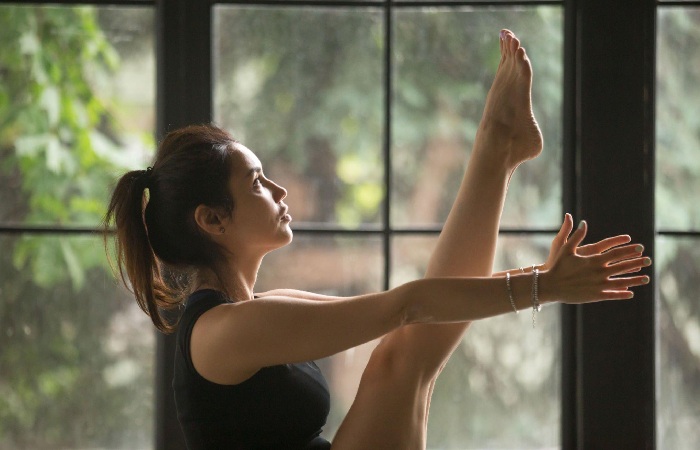The Boat Navasana, as the balancing exercise is also called, is demanding and may not be easy to do at first. However, when you master it, it will help you stay balanced and calm even in rough times, like a safe boat on a stormy sea.
Today we will tell you how this asana works, give tips on how to do the boat pose correctly and explain the effect the boat has on the body and mind.
Table of Contents
What Is Navasana – The Boat?
The pose Navasana, in English boat, is one of the 84 main asanas in hatha yoga. Asanas are postures that can be either standing, forward bends, backbends, twists, arm balances, neutral positions, or inversions. The boat is one of the exercises performed while lying on the floor. It is one of the neutral positions. The ship requires some perseverance and strong willpower of the yogi.
Some variations are suitable for beginners and those that challenge any experienced yogi. We will now present them to you.
How Does Navasana Work?
With these Navasana instructions, you can try the asana in your next practice.
- First, sit in an upright position with your legs stretched out. This position is called Dan asana and is perfect for finding the correct hip position for Navasana.
- Next, draw your knees closer to your chest. The feet remain firmly on the ground.
- Tighten your stomach and lean your upper body slightly, so you are only sitting on your tailbone.
- On the first exhale, lift one leg and stretch it out as straight as possible. On the next exhale, stretch the second leg and position it next to the first. The straight legs should form a V with the upper body. Of course, you can also stretch out both legs simultaneously.
- Extend your arms and hold them straight in the air. Your hands should be roughly next to your knees. Alternatively, you can grab your knee to get a better grip at first or if you don’t have enough strength.
- Hold the position for about ten breaths and then release the pose on the exhale, then repeat the exercise three times.
Essential For The Back: The length of the spine should be maintained at all times, and push the tailbone down. If you can’t keep your back straight with your legs straight and you notice that you’re sagging, slouching, or hunching, you should bend your legs and hold on to the backs of your knees. You may also place your arms on the floor behind your back until your abs are strong enough.
What Is The Effect Of The Boat Pose?
Navasana is a simple yoga exercise that has many benefits. Above all, Navasana strengthens the straight and lateral abdominal muscles. In addition to the physical effects, there are other positive side effects, such as the activation of the solar plexus. We will present the physical, mental and energetic results in more detail.
Physical Effect
The lower back, in particular, is protected by strengthening the abdominal muscles in the boat. Back pain is prevented or even reduced. The neck and shoulder area is also supported. In addition, the abdominal muscles can relax better after the contraction, which enables deep abdominal breathing. Feelings of fullness and gastrointestinal complaints are said to be alleviated by tensing the stomach and digestion stimulated.
Mental Effect
Navasana strengthens the abdominal muscles and our core and is, therefore, good for your self-confidence. The balance that exercise demands also positively affects our emotional life. The boat can consequently have a very balancing effect on an emotional level and can help with mood swings, for example. Willpower and courage can also be encouraged if you use the exercise regularly.
Energetic Effect
The boat is a centering asana that allows the life energy, the prana, to flow more easily. In addition, the solar plexus chakra is activated. To understand what this means, you need to know what chakras are. The energy centers of the body are called chakras. Each chakra has specific properties associated with it. The solar plexus chakra, which is just in the upper abdomen, is connected to what constitutes the self: self-confidence, self-worth, and development. Chakras are often blocked, and energy cannot flow freely. Yoga can support the free flow of energy through the body.
Boat Contraindications
The boat already requires quite abdominal solid muscles. Without these, the back cannot be kept straight. If your stomach is not yet strong enough to keep you in balance, you should urgently bend your legs to avoid injuries to your back.
People having heart problems or high blood pressure and pregnant women should not practice this asana. The boat can help with back problems, but you should talk to a doctor or trainer in advance (especially in the case of injuries such as a herniated disc).
Variations: How Else To Practice Navasana?
There are other yoga boot variants for advanced users. For example, there would be the active boat, where you combine the posture with a roll up and down. So a little more movement comes into play. In any case, you should be confident enough in Navasana to act correctly.
Other variations would be side twists. For this, you are in the boat, raise your arms, turn your upper body to the side and open your arms like scissors. The legs and feet remain still.
Conclusion
Once you’ve also mastered this exercise, you can try making the “V” bigger, i.e. lowering your upper body and legs. It makes the exercise harder with every millimeter that your back and legs get closer to the ground. Your breaths should remain even and deep despite the effort.
